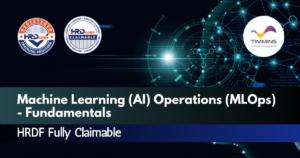MACHINE LEARNING (AI) OPERATIONS (MLOPS) – FUNDAMENTALS
Duration: 5 days
AI & ML Ops Course Overview:
Data science, AI and Machine Learning are becoming core capabilities for solving complex real-world problems, transforming industries, and delivering value in all domains. Therefore, many businesses are investing in their data science teams and ML capabilities to develop predictive models that can deliver business value to their users.
Course Objectives:
In this course, you will:
Identify and use core technologies required to support effective MLOps.
Configure and provision Google Cloud architectures for reliable and effective MLOps environments.
Implement reliable and repeatable training and inference workflows.
Adopt the best CI/CD practices in the context of ML systems.
Operate deployed machine learning models effectively and efficiently.
Identify and use core technologies required to support effective MLOps.
Who Should Attend?
Data Scientists
Data engineers & Data Analysts
Research/Applied Scientists
ML engineers
DevOps engineers
Aspiring MLOps Professionals and Enthusiasts
Machine Learning professionals who want to deploy models to production
Anyone who wants to learn Docker & Kubernetes, AWS, Azure, GCP, DVC, Feast, MLFlow etc
Individuals interested in data and AI industry
Pre-requisite
Completed Machine Learning with Google Cloud or have equivalent experience.
Course Outlines:
Module 1: Why & When Do We Need AI & MLOPs
Discuss Data Scientists’ pain points.
Identify ML Engineering characteristics and challenges.
Define how Google Cloud can help with MLOps.
Recognize how MLOps differs from manual ML management.
Compare and contrast DevOps vs MLOps.
Module 2: Understanding the Main Kubernetes Components
Define what is a Docker container.
Create Docker containers.
Identify the architecture of Kubernetes: pods, namespaces.
Create Docker containers using Google Container Builder.
Store container images in Google Container Registry.
Create a Kubernetes Engine cluster.
Manage Kubernetes deployments.
Module 3: Introduction to AI Platform Pipelines
Identify the benefits and opportunities of AI Pipelines.
Define Access Controls within AI Pipelines.
Recognize pipeline components.
List pipeline workflows.
Set up AI Platform Pipelines.
Create a machine learning pipeline.
Run a machine learning pipeline.
Connect to AI Platform Pipelines using the Kubeflow Pipelines SDK.
Configure a Google Kubernetes Engine cluster for AI Platform Pipelines.
Module 4: Training, Tuning & Serving on AI Platform
Identify the main concepts of MLOps on AI Platform.
Create a reproducible dataset.
Implement a tunable model.
Build and push a training container.
Train and tune a model.
Serve and query a model.
Module 5: Kubeflow Pipelines on AI Platform
Recognize how Kubeflow Pipelines fits in MLOps.
Describe a Kubeflow Pipeline with KF DSL.
Use the various Kubeflow components.
Compile, upload, and run a pipeline build in Kubeflow Pipelines.
Module 6: Kubernetes Deployment Strategy
Monitoring
Liveness and Readiness Probes
Labels and Selectors
Module 7: CI/CD for Kubeflow Pipelines on AI Platform
Recognize how Kubeflow Pipelines fits in MLOps.
Describe a Kubeflow Pipeline with KF DSL.
Use the various Kubeflow components.
Compile, upload, and run a pipeline build in Kubeflow Pipelines.
